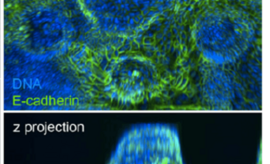Flow with variable pulse frequencies accelerates vascular recellularization and remodeling of a human bioscaffold
AbstractDespite significant advances in vascular tissue engineering, the ideal graft has not yet been developed and autologous vessels remain the gold standard substitutes for small diameter bypass procedures. Here, we explore the use of a flow field with variable pulse frequencies over the regeneration of an ex vivo‐derived human scaffold as vascular graft. Briefly, human umbilical veins were decellularized and used as scaffold for cellular repopulation with human smooth muscle cells (SMC) and endothelial cells (EC). Over graft development, the variable flow, which mimics the real‐time cardiac output of an individual performing daily activities (e.g., resting vs. exercising), was implemented and compared to the commonly used constant pulse frequency. Results show marked differences on SMC and EC function, with changes at the molecular level reflecting on tissue scales. First, variable frequencies significantly increased SMC proliferation rate and glycosaminoglycan production. These results can be tied with the SMC gene expression that indicates a synthetic phenotype, with a significant downregulation of myosin heavy chain. Additionally and quite remarkably, the variable flow frequencies motivated the re‐endothelialization of the grafts, with a quiescent‐like structure observed after 10 days of conditioning, contrasting with the low surface coverage and unaligned EC observed under constant frequency (CF). Besides, the overall biomechanics of the generated grafts (conditioned with both pulsed and CFs) evidence a significant remodeling after 55 days of culture, depicted by high burst pressure and Young's modulus. These last results demonstrate the positive recellularization and remodeling of a human‐derived scaffold toward an arterial vessel.


